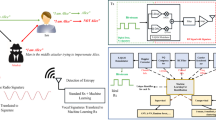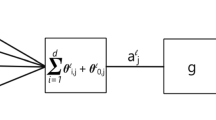Abstract
The necessity to perfectly monitor the intercepted signals for spatially-correlated multiple-input multiple-output (MIMO) systems, involves modulation identification algorithms. In this paper, we present an algorithm dedicated to the modulation identification for correlated MIMO relaying broadcast channels with direct link using multi-relay nodes. By modeling spatially-correlated MIMO channels as Kronecker-structured and the imperfect channel state information of both the source-to-destination and the relay-to-destination errors as independent complex Gaussian random variables, we firstly derive the ergodic capacity of the proposed transmission system. It turns out that the ergodic capacities improve with the number of relay nodes. Based on a pattern recognition approach using the higher order statistics features and the Bagging classifier, we show that the probability to distinguish among M-ary shift keying linear modulation types without any priori modulation information is enhanced compared to the decision tree (J48), the tree augmented naive Bayes, the naive Bayes using discretization and the multilayer perceptron classifiers. We also study the effect of increasing the number of relay nodes. Numerical simulations show that the proposed algorithm using the cooperation of multi-relay nodes with the source node can avoid the performance deterioration in modulation identification caused by both spatial correlation and imperfect CSI.









Similar content being viewed by others
References
Bahloul, M. R., Yusoff, M. Z., Abdel-Aty, A. H., Saad, M. N. M., & Al-Jemeli, M. (2016). Modulation classification for MIMO systems: State of the art and research directions. Chaos, Solitons & Fractals, 89, 497–505. doi:10.1016/j.chaos.2016.02.029.
Bahloul, M. R., Yusoff, M. Z., & Saad, M. N. M. (2015). Robust and reliable modulation classification for MIMO systems. Applied Mathematics & Information Sciences, 9(5), 2513.
Ben Chikha, H., Chaoui, S., Dayoub, I., Rouvaen, J. M., & Attia, R. (2012). A parallel concatenated convolutional-based distributed coded cooperation scheme for relay channels. Wireless Personal Communications, 67(4), 951–969.
Ben Chikha, H., Dayoub, I., & Berbineau, M. (2013). Distributed turbo coded cooperative networks under imperfect channel state information in Rayleigh fading channels. IET Communications, 7(10), 973–979.
Ben Chikha, W., & Attia, R. (2015). On the performance evaluation of Bayesian network classifiers in modulation identification for cooperative MIMO systems. In International Conference on Software, Telecommunications and Computer Networks (SoftCOM) (pp. 138–142).
Ben Chikha, W., Dayoub, I., Hamouda, W., & Attia, R. (2014). Modulation recognition for MIMO relaying broadcast channels with direct link. IEEE Wireless Communications Letters, 3(1), 50–53.
Bradley, A. P. (1997). The use of the area under the ROC curve in the evaluation of machine learning algorithms. Pattern Recognition, 30(7), 1145–1159.
Breiman, L. (1996). Bagging predictors. Machine Learning, 24(2), 123–140.
Breiman, L. (1998). Arcing classifiers. The Annals of Statistics, 26, 801–849.
Dabbagh, A. D., & Love, D. J. (2008). Multiple antenna MMSE based downlink precoding with quantized feedback or channel mismatch. IEEE Transactions on Communications, 56(11), 1859–1868.
Dobre, O. (2015). Signal identification for emerging intelligent radios: Classical problems and new challenges. IEEE Instrumentation & Measurement Magazine, 18(2), 11–18.
Dobre, O. A., Abdi, A., Bar-Ness, Y., & Su, W. (2007). Survey of automatic modulation classification techniques: Classical approaches and new trends. IET Communications, 1(2), 137–156.
Fawcett, T. (2006). An introduction to roc analysis. Pattern Recognition Letters, 27(8), 861–874.
Hameed, F., Dobre, O. A., & Popescu, D. C. (2009). On the likelihood-based approach to modulation classification. IEEE Transactions on Wireless Communications, 8(12), 5884–5892.
Hassan, K., Dayoub, I., Hamouda, W., Nzéza, C. N., & Berbineau, M. (2012). Blind digital modulation identification for spatially correlated MIMO systems. IEEE Transactions on Wireless Communications, 11(2), 683–693.
Kang, M., & Alouini, M. S. (2006). Capacity of correlated MIMO Rayleigh channels. IEEE Transactions on Wireless Communications, 5(1), 143–155.
Kohavi, R., & Quinlan, J. R. (2002). Handbook of data mining and knowledge discovery. chap. Data mining tasks and methods: Classification: Decision-tree discovery (pp. 267–276). New York: Oxford University Press, Inc.
Kwak, N. (2008). Principal component analysis based on l1-norm maximization. IEEE Transactions on Pattern Analysis and Machine Intelligence, 30(9), 1672–1680.
Laneman, J. N., Tse, D., & Wornell, G. W. (2004). Cooperative diversity in wireless networks: effcient protocols and outage behavior. IEEE Transactions on Information Theory, 50(12), 3062–3080.
Loyka, S. L. (2001). Channel capacity of MIMO architecture using the exponential correlation matrix. IEEE Communications Letters, 5(9), 369–371.
Marey, M., & Dobre, O. A. (2015). Blind modulation classification for Alamouti STBC system with transmission impairments. IEEE Wireless Communications Letters, 4(5), 521–524.
McCullagh, P. (1987). Tensor methods in statistics. London: Chapman Hall.
Mühlhaus, M. S., Öner, M., Dobre, O. A., & Jondral, F. K. (2013). A low complexity modulation classification algorithm for MIMO systems. IEEE Communications Letters, 17(10), 1881–1884.
Peel, C. B., Hochwald, B. M., & Swindlehurst, A. L. (2005). A vector-perturbation technique for near-capacity multiantenna multiuser communication—part I: Channel inversion and regularization. IEEE Transactions on Communications, 53(1), 195–202.
Peng, M., Liu, H., Wang, W., & Chen, H. H. (2010). Cooperative network coding with MIMO transmission in wireless decode-and-forward relay networks. IEEE Transactions on Vehicular Technology, 59(7), 3577–3588.
Shiu, D. S., Foschini, G. J., Gans, M. J., & Kahn, J. M. (2000). Fading correlation and its effect on the capacity of multielement antenna systems. IEEE Transactions on Communications, 48(3), 502–513.
Spooner, C. M. (2001). On the utility of sixth-order cyclic cumulants for RF signal classification. In Conference Record of Thirty-Fifth Asilomar Conference on Signals, Systems and Computers (vol. 1, pp. 890–897).
Swami, A., & Sadler, B. M. (2000). Hierarchical digital modulation classification using cumulants. IEEE Transactions on Communications, 48(3), 416–429.
Tseng, F. S., & Wu, W. R. (2010). Linear MMSE transceiver design in amplify-and-forward MIMO relay systems. IEEE Transactions on Vehicular Technology, 59(2), 754–765.
Tseng, F. S., & Wu, W. R. (2011). Nonlinear transceiver designs in MIMO amplify-and-forward relay systems. IEEE Transactions on Vehicular Technology, 60(2), 528–538.
Tseng, F. S., Wu, W. R., & Wu, J. Y. (2009). Joint source/relay precoder design in nonregenerative cooperative systems using an MMSE criterion. IEEE Transactions on Wireless Communications, 8(10), 4928–4933.
Turan, M., Öner, M., & Çırpan, H. A. (2016). Joint modulation classification and antenna number detection for MIMO systems. IEEE Communications Letters, 20(1), 193–196.
Wan, H., Chen, W., & Ji, J. (2012). Efficient linear transmission strategy for MIMO relaying broadcast channels with direct links. IEEE Wireless Communications Letters, 1(1), 14–17.
Wang, Z., Chen, W., Gao, F., & Li, J. (2011). Capacity performance of relay beamformings for MIMO multirelay networks with imperfect R- D CSI at relays. IEEE Transactions on Vehicular Technology, 60(6), 2608–2619.
Weka, Machine Learning Group at the University of Waikato. http://www.cs.waikato.ac.nz/ml/weka/. Accessed 3 June 2014.
Wong, M. L. D., & Nandi, A. K. (2004). Automatic digital modulation recognition using artificial neural network and genetic algorithm. Signal Processing, 84(2), 351–365.
Wu, H. C., Saquib, M., & Yun, Z. (2008). Novel automatic modulation classification using cumulant features for communications via multipath channels. IEEE Transactions on Wireless Communications, 7(8), 3098–3105.
Yang, Y., Hu, H., Xu, J., & Mao, G. (2009). Relay technologies for Wi Max and LTE-advanced mobile systems. IEEE Communications Magazine, 47(10), 100–105.
Zelst, A.V., & Hammerschmidt, J.S. (2002). A single coefficient spatial correlation model for multiple-input multiple-output (mimo) radio channels. In Proceedings of URSI General Assembly (pp. 17–24).
Zhang, B., He, Z., Niu, K., & Zhang, L. (2010). Robust linear beamforming for MIMO relay broadcast channel with limited feedback. IEEE Signal Processing Letters, 17(2), 209–212.
Author information
Authors and Affiliations
Corresponding author
Rights and permissions
About this article
Cite this article
Ben Chikha, W., Attia, R. On the utility of MIMO multi-relay networks for modulation identification over spatially-correlated channels. Telecommun Syst 64, 735–747 (2017). https://doi.org/10.1007/s11235-016-0204-0
Published:
Issue Date:
DOI: https://doi.org/10.1007/s11235-016-0204-0




